Employee engagement. What a concept.
Companies spend hundreds of millions of dollars every year on it . On increasing it, on measuring it, and on fixing it.
Yet sadly, a vast majority of employees aren’t fully engaged with their work globally. Eighty-five percent of the global workforce is just going through the motions:
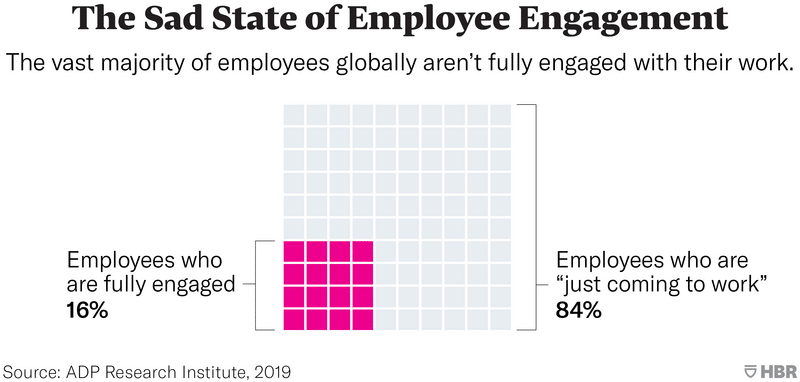
The figures are kind of depressing.
If you’re running a small business that’s struggling with unenthusiastic employees, you’re not alone.
The first step to solving the problem? Correctly diagnosing it. And to do that, we have a solution for you: ask better questions in your employee engagement surveys. (Employee engagement apps are another option you can look at.)
In this article, we’ll cover everything you need to know about just how to do that—and hand you a shiny list of 30 questions that’ll help you get to the heart of the matter. Let’s look at:
- What employee engagement is
- What an employee engagement survey is
- 30 questions to add to your employee engagement survey
- Best practices to get the most out of your employee engagement survey
✍️ Need help building better employee reviews? ✍️
We made you a template that’s competency based and includes specific criteria for remote team members!
What is employee engagement?
Employee engagement refers to a measurable, clearly defined set of attitudes that lead to better productivity metrics, innovation, retention, and more. In other words, it’s key to good employee morale.
According to ex-Galluper Marcus Buckingham and Cisco VP Ashley Goodall, these “…attitudes seem to cluster around consistent themes, such as a clear sense of purpose, a commonly held notion of what’s valuable or important, feelings of psychological safety, and confidence about the future.”
According to Jim Harter, Chief Scientist of Workplace Management and Well-Being at Gallup, “… engagement is not determined by an abstract feeling. Measuring workers’ contentment or happiness levels, as well as catering to their wants, often fails to achieve the underlying goal of employee engagement: improved business outcomes.”
Meaning: it’s not just some fluffy concept! There’s a way to measure it—and by extension, strategically improve on it.
According to Gallup’s State of the Global Workplace report, engaged employees are less absent, more productive, and more profitable to the bottom line:
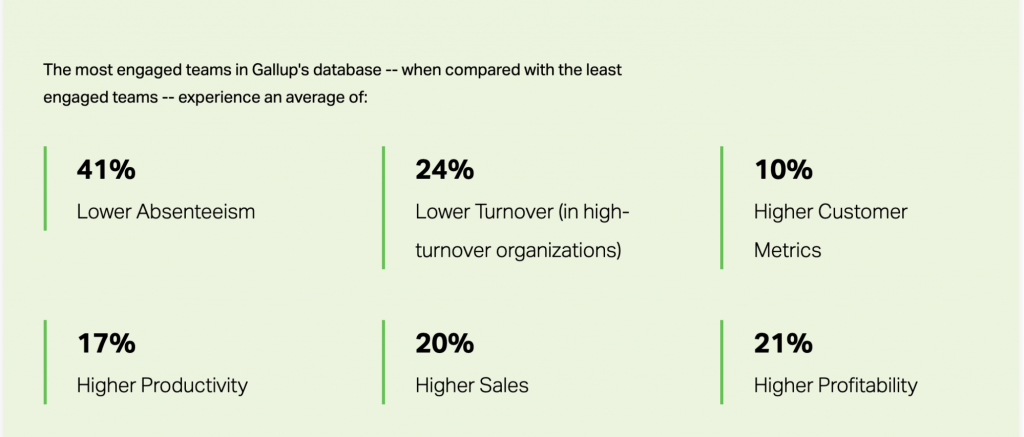
According to Gallup’s State of the Global Workplace report, engaged employees bring more to the table.
Disengaged employees, on the other hand, cost their companies 34% of their salary.
What is an employee engagement survey?
An employee engagement survey is one of many tools that you can use to measure, well, engagement. The others are one-on-one interviews, focus groups, and number-crunching AI tools that measure it without you lifting a finger!
Surveys are usually held either annually or quarterly. (More frequent ones are referred to as pulse surveys.)
They’re among the most direct routes to the heart of your employees’ concerns—and an effective way to diagnose problems (if there are any).
How to get the insights you need from employee engagement surveys
Do you know which company has nailed employee engagement? Google. And do you know which company has nailed surveys? Gallup. Here are some brain pickings from them and the United States Office of Personnel Management:
- Use clear, simple language, and use terms your employees won’t have to look up.
- Ask both structured and open-ended questions, but don’t rely too heavily on the latter. Structured questions include Likert Scales (think: 1 to 5 scales), agree/disagree statements, and multiple choice questions.
- In some cases, it’s a good idea to ask your employees to give definitions in writing. For instance, “What does a rewarding career mean to you?”
- Be specific. Stick to one concept per statement, and make sure the response options relate directly to that item.
- Don’t get too cute, or lose the clarity of your question in humor.
- Keep the survey as short as possible.
- Consider the expectations your questions might create. Don’t ask “Would your life be better with 6 months of paid leave for new pet parents?” if you have no intention of bringing in paid leave for new pet parents.
30 good employee engagement questions to sharpen your survey
Employee engagement is no longer siloed. It’s inseparable from concepts like mental health, diversity and inclusion, and work-life balance. The following questions and statements address these categories. (Feel free to adjust the phrasing to suit your questionnaire format.)
Purpose
1. The work I do is important in the grand scheme of things.
In 2016, Deloitte found that millennials believe businesses’ sense of purpose should be far greater than what it currently is.
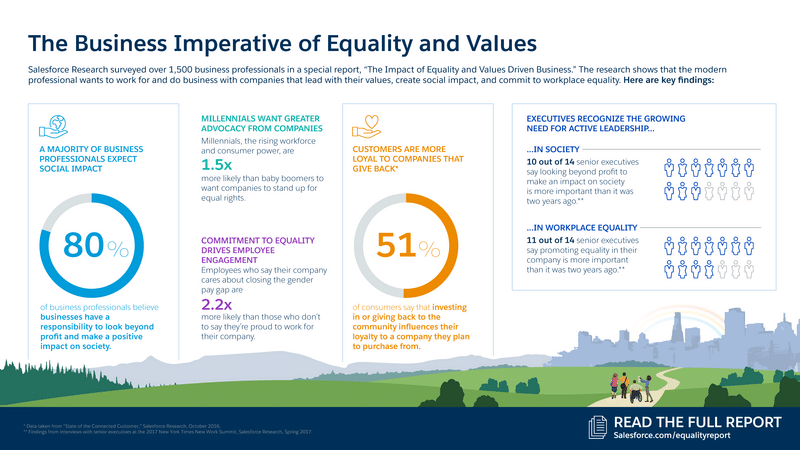
From salesforce.com
2. On a bad day, what keeps you from throwing in the towel?
If the answer points to a paycheck, there is a problem. If it doesn’t, study the details. What persuades an employee to stay put?
3. If my company succeeds, I succeed.
Believing in the company vision and mission is one thing, but emotional connection is another. Research shows that people who personally connect with the purpose of their organization make for happier and more engaged employees.
4. The leadership in my company motivates me to do my best for the company’s mission and vision.
Leaders have a huge responsibility in employee engagement and communicating the meaningfulness of the company’s work. This statement addresses their effectiveness.

5. What are the top three things that matter the most to you in life, and where does work fit in?
If work is among the priorities, that’s great. If it’s not, how does your employee relate to it? This also gives context to their answers to the rest of the survey.
Leadership
6. There is someone at work who encourages my development.
This one is from Gallup. Its analytics find that “… this is one of the best survey questions that separate enthusiastic, high-performing workers from low-performing, miserable ones.”
7. My company’s leadership ascribes to a strong ethical code and high standards of integrity.
Millennials, who’ll make up 75% of the workforce by 2025, have strong personal values and demand the same high standards from their organizations.
8. When I voice my opinions, I feel heard.
Passion and purpose quickly fizzle out if employees feel that their knowledge and experience are undervalued. A 2017 Salesforce study found that employees who feel heard are 4.6X more likely to feel empowered to perform their best work.
9. At work, I clearly understand what is expected of me.
Apart from being the mark of an efficient and organized team, according to Harvard Business Review (HBR), an affirmative answer to this statement corresponds with a high level of trust in the team leader.
Sense of belonging
10. I feel comfortable expressing my racial and gender identity at work.
As workplaces get more diverse, a one-size-fits-all approach to workplace perks can alienate minorities. Do your office lunches take place at halal restaurants for the benefit of your Muslim employees? Can a new mother comfortably place pictures of her children at her desk?
11. My team inspires me to do my best work.
Answers to this question will give you keen insights, but it’s important to gauge these against other factors that might be impacting the employee’s performance. For instance, where they are in the following grid:
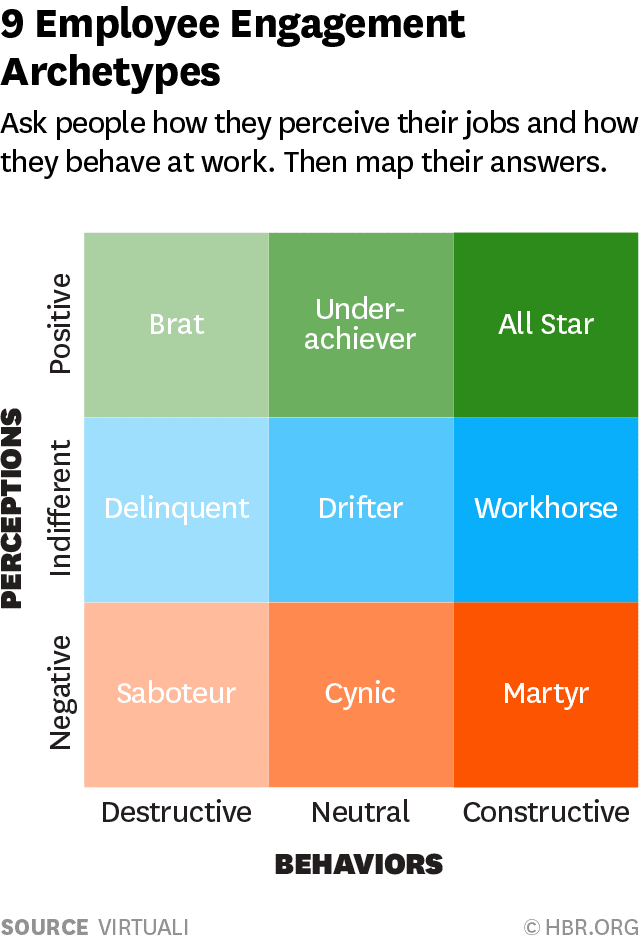
12. I have received recognition for my work at least once in the past month.
It’s important that an employee feels valued at work, and adding specifics like forms of recognition can make “feeling valued” less of an abstract concept.
13. I get along well with my colleagues.
With employees spending at least a third of their days at work, their officemates become like a second family, contributing to the office culture. Employees don’t need to be BFFs with their colleagues, but those who gel well with their teams are more likely to be engaged and enjoy work.
Employee experience
14. My workspace is conducive to my productivity.
A lot has been said in the cubicle vs open-plan debate, and preferences are extremely individualistic. This is why companies like Microsoft have been investing heavily to offer both in their interiors. While it can’t possibly be the only reason an employee is unproductive, it’s still an important factor to consider while evaluating other aspects of employee engagement.

15. Logistics and projects run smoothly in my organization.
How easily is the employee able to access the resources they need and people they need to speak to? Is there a Gordian knot of red tape? It might be time to consider using a project management tool to make sure things go smoothly.
16. I am proud to work at (Company), and I would recommend it to people I care about.
If the employee answers no to either of these clauses, it might be worth looking into. Leave a box after so they can give a reason why.
17. For the amount of work that you do, how much do you feel you should be paid?
The hidden question here is “Are you feeling overworked?” Overworked employees risk burnout, and burned out employees eventually become disengaged.
Personal development
18. Have you recently thought about leaving (Company)?
This is important to include if your company struggles with a high attrition rate. Interpret answers to these questions in the context of the others to diagnose the cause.
19. Do you have a roadmap to your progress at (Company)?
Employees who know where they’re going and see a clear line of progression in their workplace are less likely to leave.
20. My skills in (Skill Area 1), (Skill Area 2), (Skill Area 3) have improved since I joined (Company).
Forty percent of employees who receive poor job training leave their positions within the first year. A majority of training happens informally, so it’s important to be as clear and specific to ensure your employees are receiving the support they need to grow.
21. How does your work today help you advance towards your goals?
This line of questioning tells the employee that their goals are important. Act on these findings to align their roles, or tweak your internal communications to bring employee goals to the forefront.
Employee engagement survey questions for remote employees
22. My manager is approachable.
Long-distance relationships are the same in all aspects—communication (or at the very least, a good communication tool) becomes doubly important. The manager, handling a number of employees at once, is a custodian of these relationships and has a huge role to play in engaging employees.
23. My work schedule provides me with flexibility.
Millennials prioritize flexibility and seek remote opportunities for a better work-life balance. However, if their arrangement fails to provide them with this, engagement can suffer.
24. I feel connected to my coworkers.
Remote work can be very isolating, and it’s a hard-to-ignore con of remote work. If most of your employees answer in the negative, consider using tools like RingCentral Video to schedule weekly video conferences and get creative with these events:
25. I have the resources I need to perform my duties at work as well as I can.
Since communication is key, this question helps identify if anything is lacking in communication from department to department, or along the chain of command.
26. What could (Company) be doing better to help you reach your work and personal goals?
Leave this question open-ended to see what you’re missing and what you could be doing better. Encourage your employees to be as elaborate as possible.
Employee engagement questions about inclusion
27. Have you experienced changes in sleep, appetite, energy level, concentration, daily behaviour or self-esteem?
A lot of people experience symptoms without seeking a diagnosis. Hence, instead of asking if the employee has been diagnosed with depression, which can be worrying to disclose, ask about specific symptoms instead.
28. Racial slurs, sexist jokes and other politically inappropriate remarks are not tolerated at (Company).
Do offensive and inappropriate remarks fly in the break room? Asking specific questions about the minority experience leads to far better results.
29. I know how to file a sexual harassment complaint and I am confident it will be handled well.
This question clearly communicates that safety is a priority to womxn at work, and ensures that all employees are aware of the procedures.
30. I can access all spaces and the resources I need at work comfortably.
It’s often easy to take access for granted in an abled world, and it’s important not to let any invisible disabilities like chronic illness fly under the radar.
Best practices to conduct fair and empirical employee engagement surveys
Make sure you act on the findings
To get the most out of surveys, you need to assure your employees that the results will make an impact (without hurting them). Employees become disillusioned when surveys repeat but their lives don’t get better. Therefore, make a commitment to yourself and to your employees to action the insights you glean from the survey findings.
Check in regularly
Work frequent check-ins and schedule regular feedback. You can do this pretty easily through your team messaging app. On RingCentral, for example, you can do this by creating a new team that works as a “Suggestion Box” where employees can drop in their ideas and suggestions easily:
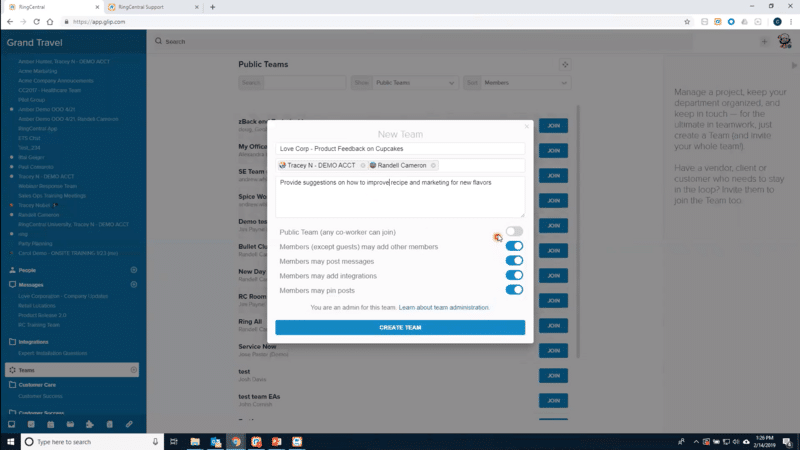
Create a new team on RingCentral dedicated to feedback.
Keep the data private
Employees won’t be completely honest if there’s a chance that the information they provide will reach the wrong ears. Can you blame them? The questions in engagement surveys can be quite… shall we say delicate?
Segment
Make sure to segment the survey data by gender, ethnicity, generation, geography, tenure, and role in the company. “By only looking at the total numbers, employers miss out on opportunities to identify issues among smaller groups that could be leading to attrition as the views of the majority overpower those of minorities,” writes Karen Brown, founder and managing partner of Bridge Arrow, a diversity and inclusion management consulting firm.
If your survey has to give you granular information, make sure to account for the minorities among your teams.
Keep it going even for remote teams
Remote work is slowly taking over the world and so is its new baby cousin: work from home. According to HBR, 23% of workers reported that they work from home most of the time, and they turned out to be more engaged than colocated workers—20% versus 15.8%.
Not only that, only 55% of remote workers reported that they feel like they’re part of a team. By contrast, only 17% of colocated team members who reported feeling part of a team are fully engaged.
These are numbers you can’t ignore. Want to help them feel more engaged? Communicate with video. The best way to have a deep conversation is face-to-face, but the second-best is to video-chat in HD.
Use a video conferencing platform like RingCentral Video, and pair that with regular informal check-ins and pulse surveys.
Beyond the employee engagement survey
Creating a culture of engagement doesn’t begin and end with a set of surveys, fun perks, and foosball tables.
Just like any relationship, it takes work and consistent communication, along with a willingness to overhaul the “old ways” of working and refocus energy on the important stuff: positive workplace relationships, recognition, ongoing performance conversations, and opportunities for personal development.
The best surveys act not as diagnostic tools but as openers of dialogue.
And your employees? They’ll be glad you asked.
Originally published Mar 02, 2020, updated Apr 21, 2022






